#tiny yellow sawfly
Explore tagged Tumblr posts
Text
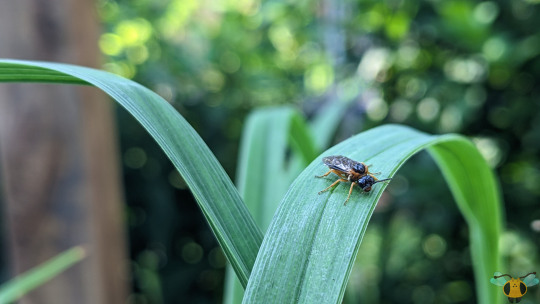
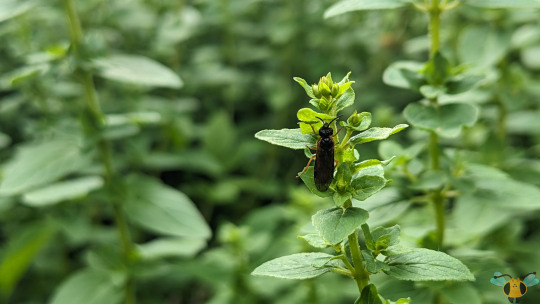
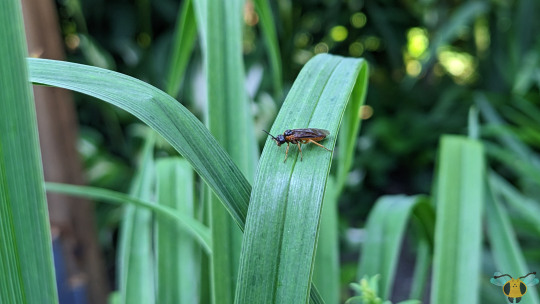
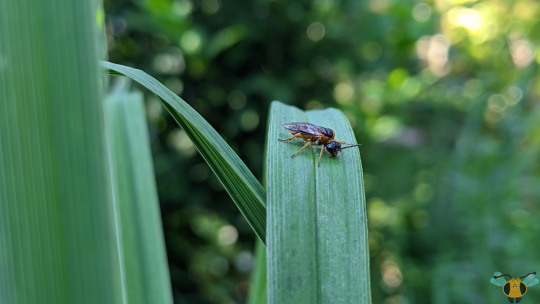
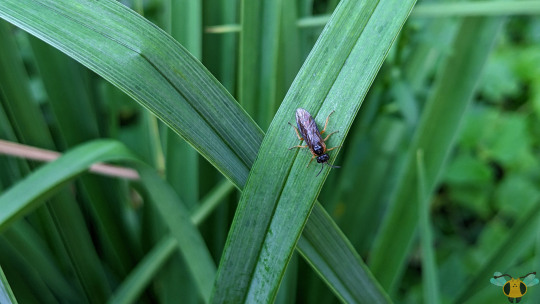
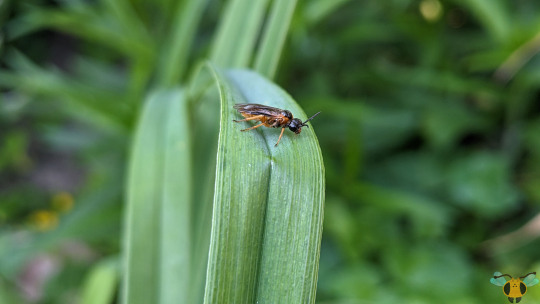

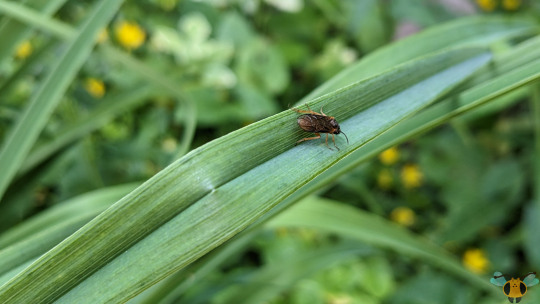
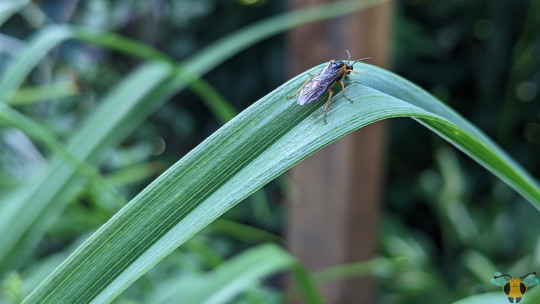
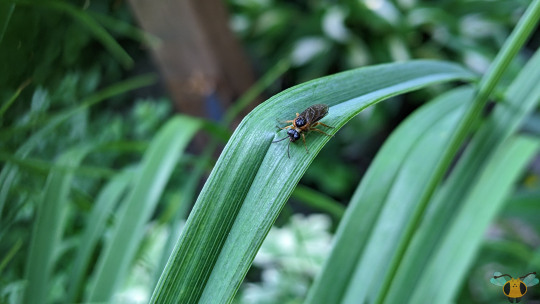
Tiny Yellow Sawfly - Monostegia abdominalis
It's a surprise to see this colorful insect in the yard again! The primary reason being that the primary food source of this insect's larvae has been completely removed from the backyard, that being the purple loosestrife plants. Over many years, the loosestrifes we've have been healthy until summer arrived and the larvae of this Tiny Yellow Sawfly appeared in droves to hungrily munch on the leaves. Try and we may to remove them, the larvae were too voracious and there were always a few left to fully consume any leaves they could! As skeletonizers, they feed on the greens (or purples) of the leaves, leaving only the veins. While the larvae are content to feed, the plant's health deteriorates tremendously without the ability to photosynthesize efficiently. As such, the loosestrife plants in the backyard faltered and died, while the Sawfly larvae that remained active went on the pupate, blissfully unaware that their food source would be no more. This isn't a problem, however, for the adults that would emerge later in the spring as the adults primarily feed on nectar and pollen from flowers and can navigate to new areas using their newly developed wings.
I'm making the situation far more dramatic than it needs to be, but this event does provide an important lesson on watching over your plants, pest control and not consuming something to the point where there won't be any left for future generations. The latter is something that the emergent adult Sawflies will have to contend with as they now have to search in a new area for a suitable host plant for their eggs. If they can find one, the saw-shaped ovipositor will go right to work and place the eggs securely within loosestrife plants and primroses. This is why it is a surprise to see this specie in the yard. The primary food source is gone, but they must a new host plant in order to ready the new generation for the summer. I really do find Sawflies quite fascinating, but I wish they weren't so destructive in their feeding habits (and there are some species that can clog up a plant using webbing, shed skin, and frass collection), even if they have to feed to support their growing larval bodies. The plants may have also fared a bit better had a predatory insect or a bird taken an interest in eating them, but a waxy coating makes them unpalatable. Best of luck to all the Sawflies out there searching for a suitable host plant, and to all you gardeners out there, please stay vigilant. Remember, they many resemble Caterpillars when they are young, but there are in reality Hymenopterans, so Caterpillar-be-gone will have little to no effect on removing them.
Pictures were taken on July 5, 2023 with a Google Pixel 4.
#jonny’s insect catalogue#ontario insect#sawfly#tiny yellow sawfly#hymenoptera#insect#toronto#july2023#2023#nature#entomology#invertebrates#arthropods#animals#photography
3 notes
·
View notes
Text
Plant Health Care Issues for Roses
Roses are a popular plant choice for homeowners, representing beauty and elegance, gracing gardens and landscapes with vibrant colors and rich fragrances. However, these delicate flowers are also susceptible to various types of disease and pests that can compromise their health and appearance. We have treated rose plants at multiple residences this season, and below we discuss some of the common plant health care issues for roses, focusing on disease prevention and treatment methods to help you keep your roses thriving and disease-free.

Rose Diseases
Common rose diseases in Pennsylvania include powdery mildew, Botrytis blight, Rose Mosaic virus, Crown Gall, and stem canker. Some of these diseases are fungal infections, while others are viral.
Powdery Mildew
Powdery mildew is one of the most common foliar diseases of roses. The white, powdery fungal growth can be very disfiguring, with repeated heavy infection reducing plant vigor.
The powdery mildew fungus that affects roses is Podosphaera pannosa var. rosae, formerly known as Sphaerotheca pannosa. Powdery mildew usually appears in spring or autumn when conditions are warm and humid, though plants can be affected at other times of year if conditions are right.
This a Rose bush we treated on a property for two common problems, including powdery mildew, that are relatively easy to identify. Powdery mildew is the cause of white and light grey spots on the leaves. The holes are caused by slug sawfly larva feeding on the leaves. Both will be treated and this rose will fully recover.
Rose Rosette
Rose rosette disease affects multiflora rose and ornamental Rosa genus plants., is caused by a virus (Emaravirus sp.) that is spread by a very small, eriophyid mite (Phyllocoptes fructiphylus). The mite feeds on the underside of leaves and injects saliva into the leaf tissue. The virus is then transmitted to new leaves when the mites move to new plants. They are wingless, but they can be carried on the wind or on clothing to new plants.
The symptoms of rose rosette appear as raised brown spots on new growth and on flowers. As the disease progresses, it causes deformation in the leaves and stems so that they resemble witches’ brooms.
Botrytis Blight
Botrytis blight is a fungal disease that is quite common in roses. Most common in cool, damp weather, the fungus infects the plant, causing gray spots on the leaves and petals. The fungus can also move to the cane, or stem of the rose plants.
Rose Mosaic Virus
Rose mosaic virus is a viral disease that causes yellowing and distortion of leaves. Aphids and thrips can transmit it. An important distinction between rose rosette and rose mosaic is that the rose rosette virus will kill the infected rose plants. Rose mosaic virus disease may cause symptoms such as slow growth, reduced flowers and increased susceptibility to frost for the entire life of the plant.
Crown Gall
Rose crown gall is a bacterial disease that causes tumor-like growths on the stems and roots of roses. Often considered a minor problem, it can cause considerable aesthetic damage to plants if left untreated.
Crown gall is caused by the bacterium Agrobacterium tumefaciens (AT) and is spread by infected plant material. The pathogen enters through wounds in the plant tissue, which may be caused by pruning, transplanting or other physical damage. Once inside, AT causes abnormal cell proliferation. This results in warty growths on the stem or root called galls.
Rose crown gall symptoms include the following:
decreased blossoms
formation of large, irregular swellings at ground level
brown discoloration of affected stems
The disease can be spread by pruning equipment, or by galls breaking down in the soil. In the latter case, the pathogen can survive up to 3 years.
Cankers
Cankers are caused by a variety of fungi. These diseases cause reddish brown spots on canes (stems) that become covered with tiny black dots. Cankers can eventually kill the cane, and can be spread through pruning equipment.
Preventing Health Issues For Roses
To prevent these diseases and other plant health care issues for roses, good cultural methods such as proper watering, pruning, fertilization, and soil care are vital. Additionally, organic or chemical control methods, such as fungicides and horticultural oils, can protect your roses from diseases.
Good Air Circulation
Proper air circulation is crucial for maintaining the health of your roses. Good air circulation helps prevent the growth of fungal diseases by reducing humidity around the plants. To achieve this, roses need to be spaced adequately, pruned regularly, and any weeds or debris that may obstruct airflow need to be removed. Research has shown that proper air circulation can significantly reduce the incidence of diseases like powdery mildew in roses.
Resistant Varieties
Some rose varieties are more resistant to certain types of disease and pests than others. Choosing resistant varieties can reduce the need for chemical treatments and make maintaining plant health more manageable. Recommended disease-resistant rose varieties include ‘Knock Out,’ ‘Carefree Beauty,’ and ‘New Dawn,’ among others.
Early Spring Care
In early spring, roses need to be pruned to remove dead or diseased wood, fertilized with a slow-release fertilizer, and a dormant oil should be applied to control pests. Proper pruning is essential, as homeowners run the risk of wounding their plants by not making careful, precise cuts.
As an example, the best way to prevent crown gall is to avoid wounding plants when pruning or transplanting them.
Applications
Fungicides can be an effective tool for preventing and treating rose diseases. Botrytis blight, for example, can be treated with a fungicide spray, but it should be done as early as possible, before the fungus has had time to spread. An important note is that fungicides must be applied carefully to avoid resistance development.
Insecticides or horticultural oils can be useful to help control pests, such as aphids, and disease. Viral diseases like the rose mosaic virus can be controlled by systemic insecticides containing antibiotics to prevent infestation of aphids and thrips.
Contact Burkholder PHC for Plant Health Care Issues for Roses
If you want to keep your roses vibrant and maintain other healthy plants on your property, contact Burkholder PHC for more information or to schedule a consultation. Burkholder PHC has a team of experienced, qualified experts that can help homeowners maintain the health and appearance of their roses and other plant life. With years of experience in the field, our team knows how to treat plant health care issues for roses and high value landscape plants.
Blog is originally published at: https://www.burkholderphc.com/plant-health-care-issues-for-roses/
It is republished with the permission from the author.
#plant health care#plant health care issues for roses#roses#plant health care in Malvern#plant care#Malvern plant health care
0 notes
Text
5 Garden Pests – Insect Identification & Treatment Tips
Prevent your garden from being devoured by uninvited pests. By knowing how to protect your garden from a variety of insects, you can grow your plants and crops stress-free.
gardeninginfo-online.com gathered the following information and tips to help you eliminate garden pests naturally, without using harsh chemicals.
Garden Pests – Identify and Combat These Insects
The following common garden pests, if left unchecked, can consume enough of your garden to leave your plants in poor health and your crops partially destroyed.
Slugs and Snails
Basically, slugs are snails without the shell. These gastropods eat large, ragged holes in the foliage of plants and can entirely consume seedlings. Slugs and snails pose a particular threat to:
Violets
Lilies
Cabbage
Lettuce
Strawberries
Spider Flowers (Cleome)
Floss Flower (Ageratum)
Hostas
The more problematic species of slugs and snails include:
Garden Snail (Helix aspersa)
Grey Garden Slug (Deroceras reticulatum)
Tawny Garden Slug/Cellar Slug (Limax flavus)
Leopard Slug (Limax maximus)
Slugs and snails travel over a trail of mucus, seek protection from dehydration in cool, shaded, and damp locations. Unless disturbed or treated, they will return to their hiding and feeding places nightly.
You can confirm the presence of snails and slugs in your garden by the dried mucus/slime trails they leave behind.
Control measures include:
Physical removal, when combined with other control measures, is an effective and long-lasting method of control.
Diatomaceous earth or “DE” sticks to the snail or slug’s body, causing desiccation. DE dust should be applied in inch-wide bands near and around your plants and garden. Reapplication may be necessary after heavy rain.
Copper strips fastened to flower bed containers or boxes are incredibly effective. Snails and slugs have a shock-like reaction when they are in contact with the metal.
Commercial traps, boards, tiles, shingles, or anything that offers daytime protection are very effective in trapping this pest.
Yeast trapping is another efficient method of control. Shallow containers filled with water and yeast or beer lure snails and slugs to the container only to fall into the liquid and drown.
While there are chemical control methods, it is highly recommended to seek natural, chemical-free solutions. If chemical control is used, pay particular attention to the label and its safety measures.
Caterpillars
Caterpillars are moths and butterflies in their larvae stage. These insects chew irregular holes in leaves or flowers and can entirely consume seedlings, young shoots, buds, leaves, or flowers.
A caterpillar’s diet is comprised almost exclusively of plants. Most caterpillars can be found consuming plant foliage, but some may feed on seeds, roots, stems, fruit, or flower petals.
Tip: Caterpillars can be identified by the three pairs of (true) legs behind the head and five or fewer pairs of leg-like appendages on some but not all abdomen segments. These features distinguish them from beetle, fly, and sawfly larvae.
Some of the more common, problematic species include:
Tent Caterpillar (Malacosoma americanum)
Evergreen Bagworm Caterpillar (Thyridopteryx ephemeraeformis)
Banded Woollybear Caterpillar (Pyrrharctia isabella)
American Lady Butterfly (Vanessa virginiensis)
Common Buckeye Butterfly (Junonia coenia)
Giant Leopard Moth Caterpillar (Hypercompe scribonia)
Bent-line Gray Caterpillar (Iridopsis larvaria)
Fruit Tree Leafroller Caterpillar (Archips argyrospila)
Cabbage Looper Caterpillar (Trichoplusia ni)
You can easily confirm the presence of caterpillars by examining the extensive damage to foliage, leading you to the insect’s presence. Caterpillars feed practically non-stop until they enter the pupa stage of their lifecycle.
Control measures include:
Pruning off rolled or webbed leaves and handpicking caterpillars from plants.
Applying bacillus thuringiensis-kurstaki (Btk) an organic microbial insecticide that kills only caterpillars. This product is safe to use around bees, beneficial insects, and wildlife. Newly hatched caterpillars must feed on treated leaves to be eliminated. Treatment timing is critical in early to mid-spring.
Covering your plants or crops with an insect barrier fabric (floating row cover). The covering forms a barrier, keeping moths and butterflies from laying eggs on the plants.
Neem oil can be sprayed directly on plants and foliage throughout late winter and spring to prevent egg laying and deter caterpillars from consuming the plant.
If commercial pesticides are used, pay close attention to the label and use only as directed. When treating edible plants, it is highly recommended to use organic alternatives.
Tip: When physically removing caterpillars from your garden, keep a container with a warm water and detergent solution handy. This solution kills caterpillars quickly.
Beetles
The beetle family (Coleoptera) consists of thousands of species, both destructive and beneficial, all necessary to maintain equilibrium in our environment. The following beetles are considered beneficial in a garden setting:
Tiger Beetles (Cicindelinae)
Soldier Beetles (Cantharidae)
Lady Beetles (Coccinellidae) also called ladybirds and ladybugs
Lady Beetle Larvae
These beetles spend their larval stage and adulthood consuming aphids, mealybugs, small invertebrates, and other insects. The following beetles devour plants, leaves, flowers, and can severely damage or kill trees:
Japanese Beetles (Popillia japonica)
Black Blister Beetles (Epicauta pensylvanica) Meloidae family
Red Milkweed Beetles (Tetraopes tetrophthalmus)
Cottonwood Borer (Plectrodera scalator)
Northeastern Sawyer Beetle (Monochamus notatus)
Rose Chafer (Macrodactylus subspinosus)
All beetles have a set of hard outer wing cases, known as elytra, and a hard upper body called a carapace. The elytra cover the flight wings and come together to form a straight line down the back. Beetles all have chewing mouthparts, powerful jaws, and antennae that are often longer than their boy length.
Damages may include boring holes in stalks and trunks, and partially or entirely consumed foliage, flowers, or fruit.
Control measures include:
Apply floating row covers
Prune and destroy (burn) affected stems and foliage
Handpick them and drown in a warm water, vinegar, and detergent solution
Spray foliage and stems with insecticidal soap or neem oil
Set out lures to draw soldier beetles (predators) to your yard and garden
Tip: You can attract soldier beetles by cultivating pollen-producing plants and allowing milkweed and wild lettuce weed species to grow.
Note: Using commercially produced chemical sprays or deterrents may cause severe damage to beneficial insects and the plant itself. It is highly recommended to use organic alternatives when treating consumable crops.
Aphids
Tiny aphids (Aphidoidea) congregate and quickly reproduce to form large groups that wound and suck juices from the host plant to the point of causing it to wilt, dehydrate, die. Without control measures, a small aphid issue can become an out-of-control infestation.
Aphids have long antennae and two tubes projecting from the rear of their abdomen. They are found in green, yellow, red, brown, or gray. They may be winged, depending on the species and life stage.
They usually congregate on fruits and vegetables, flowers, ornamentals, and even shade trees throughout the North American continent. Aphids feeding on plant sap cause foliage to distort and drop. Honeydew excreted on leaves promotes sooty mold growth, and their feeding can spread viral plant diseases.
The honeydew produced by aphids not only causes the growth of sooty mold, but it also attracts other insects, including ants, that compound the pest problem.
Control measures include:
In infested areas, frequently wash sturdy plants with a strong spray of water
Attract native predators and parasites such as aphid midges, lacewings, and lady beetles
Cover plants with floating row covers
Apply hot-pepper, garlic repellent sprays
When infestations become severe problems, apply horticultural oil, insecticidal soap, or neem oil
Note: Aphid infestations are typically accompanied by an ant infestation. Ants “herd” the aphids and farm the honeydew to nourish their colony. Once you control the aphid infestation, direct your attention to controlling the ants.
Ants
Individual ants are members of highly organized colonies. They are always in search of nourishment and water to promote the health and growth of their colony.
Once a source of nourishment is located, ants will return to their colony via a pheromone trail, which is the path for the rest of the colony to follow. As long as the pheromone trail exists, ants will follow it regardless of your control measures.
Ant colonies can consume incredible amounts of plant foliage, but, as previously mentioned, they can also “herd” aphids to collect the honeydew they produce after consuming the juices from your plants.
Some of the more destructive ant species are:
Black Garden Ant (Lasius niger)
Black Carpenter Ant (Camponotus pennsylvanicus)
Fire Ants (Solenopsis invicta) also known as Red Imported Fire Ant (RIFA)
Wood Ants, Mound Ants, Thatching Ants, and Field Ants are all part of the genus Formica
Leafcutter Ants are part of nearly fifty species belonging to the Atta and Acromyrmex genera
Control measures include:
Squeeze a lemon or an orange over areas where the ants transit
Sprinkle pepper, salt, cayenne pepper, or cinnamon around areas you wish to protect
Peppermint or white vinegar can be spread around to repel them
Spray ants with a mixture of water and dish soap (the soap penetrates their exoskeleton and kills them)
Lay a one-inch strip of food-grade diatomaceous earth by trails and nests
Set borax (or boric acid) and sugar poison traps around your plants
Set traps with powdered sugar and baking soda (the baking soda dries their bodies and kills them)
Eliminate aphids from your garden
Tip: Wherever you see an ant trail, make it your goal to interrupt the pheromone trail they are leaving behind. You can accomplish this with diluted white vinegar or juice squeezed from a lemon or an orange.
Note: When you apply salt to soil, you are altering the soil’s pH and potentially harming the plants growing there.
Read the following link for additional tips and advice on keeping pests out your garden, and check out this simple recipe for homemade non-toxic pesticides for your garden.
Garden Pest Control
In this article, you discovered information on how to identify and eliminate 5 destructive garden pests without using harsh chemicals.
When you take action to control and eliminate garden pests, you can preserve your garden and crops, harvesting pristine fruits and vegetables.
Allowing garden pests to flourish can lead to massive infestations leaving your garden looking chewed up and dying.
Sources: extension.umd.edu/hgic/topics/slugs-and-snails-flowers wildlifetrusts.org/wildlife/how-identify/identify-caterpillars insectidentification.org/insect-description.asp?identification=Aphids extension.umn.edu/insects-infest-homes/ants caterpillaridentification.org/ ipm.ucanr.edu/QT/lfcaterpillarscard.html
The post 5 Garden Pests – Insect Identification & Treatment Tips appeared first on http://gardeninginfo-online.com.
1 note
·
View note
Photo

New Post has been published on https://malleedesign.com.au/help-whats-wrong-with-my-plants/
Help! What's wrong with my Plants?

By Kath Gadd and Hannah Preston
Well it would seem La Niña is here with a vengence along the NSW and QLD east coast, resulting in way too much rain and very uncomfortable humidity. It has been a tough summer for many plants. Not only have the weeds enjoyed an extreme growth spurt but the bugs and insects are out in full force too and the extra moisture in the air is also great for moulds and fungus to flourish. Many of you may have noticed plants being affected by this or just looking downright unhappy!
There are four factors that may be challenging your plants health at the moment and we are going to give you a quick run down…
Sap Suckers
Sap-sucking insects, such as scale, aphids and mealybugs, feed on the sugary-liquid that travels through plant tissues, slurping up the nutritious solution that should be feeding the plant! They tend to multiply quickly, weakening plants and often deform foliage. Many have tiny waxy bodies and secrete honeydew as a by-product of feeding. The honeydew attracts fungal diseases like sooty mould and also ants, which may protect the sap-suckers from predators and carry them to new plants.
Because they can be so prolific and so tiny the best way to treat them is with an insect spray. A white oil treatment is effective for many sap suckers, it coats the breathing pores of insects, suffocating them, and can be easily made up at home with dishwashing liquid and oil (you can also use other home-made mixtures like a chilli or garlic oil). Shop-bought pest oils also work – they usually operate on the same principle of suffocating pests and may contain other compounds to ensure knock-out. Pyrethrum, another good option, is slightly different. The active compound is naturally-derived from the pyrethrum Daisy and works by inhibiting an insect’s nervous system.
Whatever spray you’re using try to spray only the affected areas on both sides of the leaves/branches. Chemicals like pyrethrum are non-specific so will also kill the good insects and bees around your plants if you use them too much. Another option is manual removal. Some people have removed sap suckers by patiently scraping the leaves, or if the infestation is too large, blasting them off with a pressure hose.
Eucalypt with scale
Leaf chewers
Leaf chewing insects have specialised mouthparts and often target young, tastier leaves and little seedlings. They include things like caterpillars, sawfly larvae and slugs. They’ll often secrete toxins that make them unpalatable to potential predators like birds, and in that way, continue feeding on plants unharmed.
Some of the pest oils/sprays work for leaf chewers but you can also try manual strategies depending on the insect and its lifecycle. For example, the caterpillar on this White Cedar (Melia azedarach) below has been absolutely decimating the foliage. The grubs eat the leaves during the day then fall to the ground at night. Putting up a foil barrier around the base of the tree’s trunk seems to have stopped them being able to climb back up in the morning.
In the case of sawfly larvae, pruning off affected foliage before the infestation gets too large may be enough. Sawfly larvae feed mostly on bottlebrush. If found on established, adult plants they shouldn’t be a problem but on vulnerable, young plants you need to remove them before it’s too late.
Caterpillars on White Cedar
Foil barrier to stop caterpillers climbing up to the leaves of the tree
Deficiencies
Deficiencies usually present as discolouration in the leaves and are more common in rainy weather. Heavy rain washes out nutrients in poor soils – the washing out of nitrogen (N) and iron (Fe) can be a particular issue for natives and there have been devastating amounts of runoff and erosion in my region.
Yellowing of the leaves is one of the most common signs of deficiency. It can be hard to tell exactly what a plant is deficient in but providing some slow-release native fertiliser, iron chelates and/or adding trace elements like manganese, zinc and boron can help. Trace elements play a role in unlocking nutrients to plants, often via soil microorganisms. Soil microorganisms are the main underground energy hubs that convert inorganic forms of nutrients like nitrogen into bioavailable forms that plants can use.
Yellowing of grass tree leaves indicating nutrient deficiency
Moulds and Fungus
Mould and fungus can spread to plants via wind, water, soil and animals. Sooty mould is one of the most common variants on garden plants and it settles on the honeydew secreted by sap-suckers. It doesn’t directly damage the plant itself but when it smothers lots of leaves it can stop the plant from being able to photosynthesise. The best way to treat the mould is by treating the source of the problem, the sap-sucker! But, you can also manually wipe off thickly coated mould with a damp cloth.
Other funguses and mould to to look out for are myrtle rust, which is detrimental to many of out native tree and shrubs, beginning as purple spots and turning into yellow pustules on the under-side of leaves, this fungus needs to be removed immediately by cutting off affected leaves and branches and disposing of them appropriately, so the spores don’t spread.
Phytophora is another fungal mould that appears in humid, wet weather – it can appear as dieback on the leaf, turning into blight or rust, but also as root rot on larger specimens. It is caused by plants not coping with poor drainage and may begin as a problem around the root zone and not show up on the leaves until it’s too late.
Fungicides have limited scope and should not be expected to cure heavily infected plants, it is better to take a note of what is suffering and try to improve drainage and air flow around the plant.
The most important thing to do is keep an eye on your plants by checking them closely and regularly, especially in this weather when pests and diseases are rife.
Goodluck and I hope we get a good break from heavy rainfall soon!
Sooty mold on Lilly Pilly
Mint bush with Phytophora mould
0 notes
Text
[Video Description: a video of a sawfly larva crawling along the top of a metal sign. The tiny critter is yellow, and resembles a cross between an inchworm and a gummy worm. End video description.]
@ezrakeshet submitted: I saw this little guy on a sign today in Seattle, WA!
Ah, was that a pun? You saw them? Probably not intentional but I enjoyed it nonetheless. This little friend is a sawfly larva!
177 notes
·
View notes
Text
Last year, I wrote a post on some wasps and bees I’ve found in my garden over the nine years I’d lived here. This is the second installment of the Garden Insects series, on butterflies & moths and their larvae. Future posts will cover flies, dragonflies, ants, beetles, grasshoppers, cicadas, and other bugs — some “true” bugs and some not. Possibly even worms and slugs, though they are not insects, or even in the same phylum as insects. Speaking of phylum …
_________________
SIDEBAR: The taxonomy of the insect world, briefly.
Insects are a CLASS in terms of taxonomy, within the PHYLUM called Arthropoda that’s part of the overarching KINGDOM Animalia, which contains about 2.2 million animal species, So yes, all insects are animals, though people often dispute this in casual conversation and social media.
Depending on how a phylum is determined (including whether only extant (non-extinct) animals are included or not), there are anywhere from 5 to 36 phyla in the animal kingdom; usually lists show 7 or 9 phyla, such as this one from a Yale University course that lists 9 phyla, the first 6 of which contain animals that live only in water or mud: Porifera (Sponges), Cnidaria (Jellyfish, Coral, Sea Anemones), Mollusca (Snails, Slugs, Octopus), Echinodermata (Starfish, Sand Dollar, Sea Cucumber, Sea Urchin), Annelida (Segment Worms, Leeches), Platyhelminthes (Flatworms), Nematoda (Nematodes, Roundworms, Earthworms), Chordata (everything with a backbone, so all Birds, Reptiles, Fishes, Amphibians and Mammals, including humans), and finally, Arthropoda (Insects, Spiders, Scorpions, Millipedes, Crustaceans).
This sortable list on Wikipedia, similar to a BBC Earth list, contains 35 phyla, but often many of these are considered a sub-phylum of a more encompassing phylum. Here’s a site that lists 21 phyla, while the Tree of Life project lists just 6: Porifera and Cnidaria, as above in the list of nine, but then none of the other seven, instead adding to and replacing them with Placozoa (extremely simple animals up to 3mm in size made up of only 4 cell types; only 2 species have ever been described), Ctenophora (comb-jellies), Myxoza (several-celled parasitic microscopic organisms) and the giant group of Bilateria, which includes all the vertebrates plus arthropods, molluscs, worms, and more!
Categorising life is complicated.
And don’t get me started on the top level of life Kingdoms (or Domains or Empires):
“In summary, today there are several competing top classifications of life:
The three-domain system of Carl Woese, with top-level groupings of Archaea, Eubacteria, and Eukaryota domains
The two-empire system, with top-level groupings of Prokaryota (or Monera) and Eukaryota empires
The five-kingdom system with top-level groupings of Monera, Protista, Fungi, Plantae, and Animalia
The six-kingdom system with top-level groupings of Archaebacteria, Monera, Protista, Fungi, Plantae, and Animalia
Overall, the majority of biologists accept the domain system, but a large minority uses the five-kingdom method.” (from New World Encyclopedia: Taxonomy)
So, leaving the weeds to recap for today’s posting on insects, insects comprise one CLASS (called Insecta) of the PHYLUM Arthropoda, which also contains, in other classes (not Insecta) such animals as arachnids (spiders, scorpions, ticks, mites, et al.), crustaceans, millipedes and centipedes, horseshoe crabs, and so on.
Within the CLASS Insecta are about 30 ORDERS, including our focus today, Lepidoptera (butterflies and moths), plus:
Hymenoptera: ants, bees, wasps, sawflies … it’s a big group Hemiptera: all true bugs, within three sub-orders: Heteroptera – bugs; Auchenorrhyncha – cicadas, leafhoppers; and Sternorrhyncha – aphids, scales. True bugs are insects that have two pairs of wings and hypodermic-needle-like mouthparts, and they all undergo incomplete metamorphosis, with their young hatching from eggs to become nymphs, which are miniature versions of the adult bug minus the wings. Diptera: flies — but not all insects with the word “fly” in their names; also mosquitoes Coleoptera: beetles Orthoptera: katydids, grasshoppers, crickets Odonata: dragonflies & damselflies, each in its own sub-order Trichoptera: caddisflies Ephemeroptera “lasting a day”: mayflies Mantodea “like a prophet”: mantises Phasmatodea “like a ghost”: walking sticks
… and a couple dozen more. (Check out Bugguide’s intro or the list here.)
_________________ END OF SIDEBAR
*
Now on to the butterflies and moths, and their larva, i.e., caterpillars. (All photos from my yard this year unless noted otherwise.)
What’s interesting to me is that I commonly see both the larval and adult forms of some butterfly species, such as monarch butterflies and caterpillars (Danaus plexippus), while I typically see only either the larval or the adult form of others, such as black swallowtail butterflies (Papilio polyxenes); I’ve seen a handful of black swallowtail caterpillars in my yard this year and no adults, though I’ve seen a few flying around town. Same thing with yellow swallowtail butterflies, either Eastern tiger, Papilio glaucus or Canadian tiger, Papilio canadensis — I’m never sure which; I see lots of adults and no caterpillars, which are darned cute.
(Male) monarch butterfly, 12 Aug 2019; monarch caterpillar, 25 July 2019:
I like this monarch-in-flight photo that the motion camera caught on 2 Aug. 2019.

I’ve had two chrysalises hatch successful adult monarch butterflies in the garden, and I’ve seen at least three dozen monarch caterpillars on the milkweed plants (Asclepias syriaca and A. incarnata) since mid-July, including one large one today, which is getting to be too late for pupating, hatching, and flying to Mexico.
*
Black swallowtail butterfly, in the garden in Sept. 2015 ; black swallowtail caterpillar, 17 Sept 2019:
I’m still seeing black swallowtail caterpillars on dill in the garden now, too.
*
These are both Eastern yellow tiger swallowtails, both photographed on 25 July 2019; the one on the left is a female (more blue), the one on the right a male. I don’t have any photos of yellow tiger caterpillars, never having noticed one, but here’s one online — cute, right? Kind of like a spicebush caterpillar.
*
Similarly with MOTHS: I’ve seen loads of tussock moth caterpillars this year — it’s been a banner year for them in the northeast — but no adult tussock moths (they are beige and somewhat nondescript):

spotted tussock moth caterpillar (Lophocampa maculata) foreground, and looks like a banded tussock moth caterpillar (Halysidota tessellaris) in the background – 11 Sept 2019
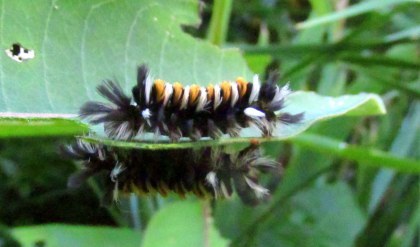
milkweed tussock moth caterpillar (Euchaetes egle), on milkweed – 25 Aug 2019
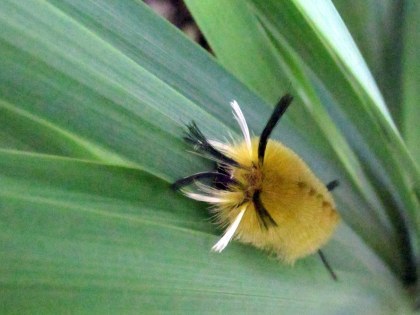
banded tussock moth caterpillar (Halysidota tessellaris) – 13 Aug 2019

hickory tussock moth caterpillar (Lophocampa caryae) – 11 Aug 2019
*
I’m likewise seeing a fair number of woolybears, those fuzzy caterpillars of the banded woolybear moth aka Isabella tiger moth, Pyrrharctia isabella or of the yellow woolybear moth, aka Virginian tiger moth, Spilosoma virginica, but I’ve not noticed any actual moths of the species:
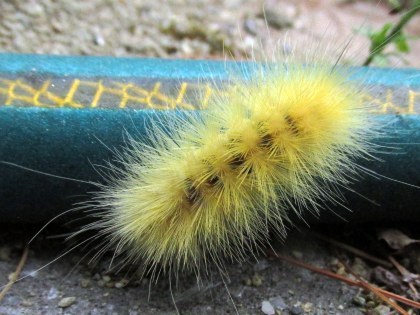
I think this is a Yellow Woolybear Moth caterpillar aka Virginian Tiger Moth (Spilosoma virginica), on the garden hose, 12 Aug 2019

And this is another Virginian Tiger Moth (Spilosoma virginica), seen not in my garden but at Laudholm Farm in Wells, Maine on 9 Sept. Quite different in appearance.

Here’s a banded woolybear moth caterpillar aka Isabella tiger caterpillar (Pyrrharctia isabella), taken nearby my home in New Hampshire last year, Oct. 2018; I’ve seen some this year but haven’t been able to get photos.
Obviously, I’m probably just not noticing or recognising the moths in their adult forms (they tend to blend), and I’m not out at night prowling around or leaving lights on to lure them, but the swallowtail situation is more perplexing to me, as they are fairly striking in both forms.
*
A new one for me this year has been the American dagger moth caterpillar (Acronicta americana). I first saw it coiled in a round disk on the patio (27 July) and wasn’t sure it was even an animal.

But folks on Facebook insect pages assured me it was. I’ve since seen the same species in other spots in the yard. Here’s a bedraggled one on a peach, 3 Sept.:

Here’s another, all curled up in a small Japanese maple (‘Bloodgood’) tree a few days ago.

There’ve been other dagger moth caterpillars around as well, including these larvae of the splendid dagger moth (Acronicta superans), both seen on 19 Aug. 2019 but at least 15 yards from each other, the first on a purple leaf sand cherry (Prunus × cistena) and the second on the shed.

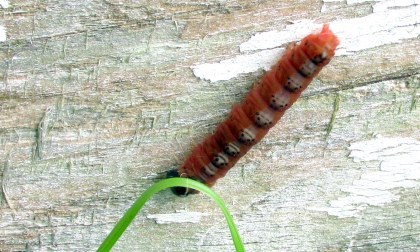
I saw this one on a sidewalk in town on 16 Aug. 2019; it’s a fingered dagger moth caterpillar.

fingered dagger moth (Acronicta dactylina) caterpillar, 16 Aug. 2019
And this one also in town, on 13 Sept. 2019, a yellow-haired dagger moth (Acronicta impleta) caterpillar:
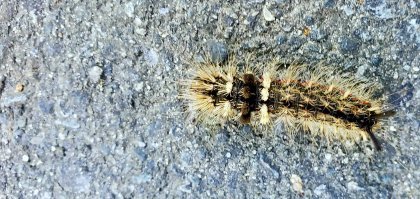
*
A couple more moth larva seen locally this summer:

rosy maple moth (Dryocampa rubicunda) caterpillar, 22 Aug. 2019, on a local trail

a polyphemus moth (Antheraea polyphemus) caterpillar ready to pupate (this is why it’s orange and not green), 26 Aug 2019, on a local sidewalk and heading toward the road (I moved it)
*
The clymene moth (Haploa clymene), a kind of tiger moth, is a very distinguishable species that I seem to see about once a summer on the lawn. This photo was taken on 30 July 2019. I’ve never noticed it in its larval form, which somewhat resembles a webworm.

*
This ipsilon dart moth was a new one for me, and I might not have noticed it on the ground if it hadn’t moved a bit. I posted it two two Facebook insect ID groups and I’m amazed that with the sunlight glaring on this specimen, two people in two separate groups actually recognised it!

Agrotis ipsilon (Ipsilon dart) moth, 8 Sept 2019
*
Another new one for me is this tiny boldly marked Archips moth (Archips dissitana), seen on Clintonia borealis (blue-bead lily) alongside a local trail, 28 July 2019; sorry it’s a bit blurry:
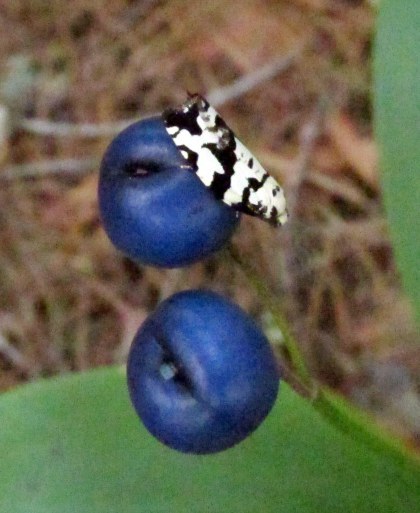
boldy marked Archips moth (Archips dissitana) on Clintonia bead, Sutton, NH, 28 July 2019
*
This giant luna moth (Actias luna) was a new and serendipitous sighting for me as well!

luna moth (Actias luna) on a local bakery storefront, 30 June 2019
*
Two moths that look more like tiny hummingbirds are the clearwing moths: the hummingbird clearwing (Hemaris thysbe) that’s olive and reddish-brown, and the snowberry clearwing (Hemaris diffinis), which is black and yellow. We’ve had many of both here all summer.
This is the hummingbird clearwing (Hemaris thysbe), on bee balm (monarda) and buddleia ‘Ellen’s Blue’:
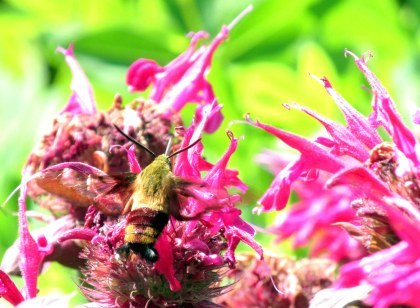
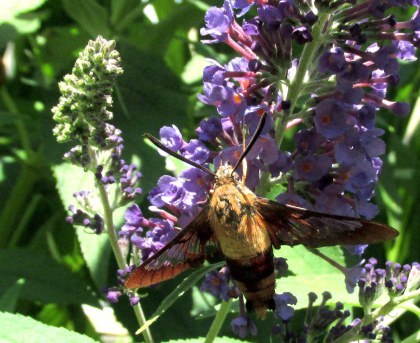
And this is the snowberry clearwing (Hemaris diffinis), on buddleia ‘Ellen’s Blue’:


I love the curled proboscis in the second photo.
*
BACK TO BUTTERFLIES
Besides the monarch and yellow swallowtails, above, another butterfly showing up here in droves this season is the painted lady (Vanessa cardui). I can’t decide if it’s more beautiful from the side or with wings open. (Shown here, on 10&11 Sept.) on buddleia, sedum, and Joe Pye weed.) There are still a lot of them around even now.
I guess I like the side the best!
Oddly, a naturalist writer near Keene, NH, about 50 miles southwest, said last week that he hasn’t seen any painted ladies this summer!
We’ve also had a fair number of American lady butterflies (Vanessa virginiensis) this season. They have only two big circles on the side of the wing, and the markings on their hindwings are quite different, too. (Shown here, from 24 July – 24 Aug,, on clethra ‘Ruby Spice’ and echinacea)
And look, I actually managed to find the larval form of the American lady!

*
I haven’t seen many white admiral butterflies (Limenitis arthemis) in the garden this year, but was able to photograph the tattered varmint on buddleia on one of the few days when I did (11 Sept. 2019). It’s a strange species, having two very different forms that used to (understandably) be considered two separate species; one is a red-spotted purple form, and the other is the “white” version, which is really black, white, blue, and reddish.

Last year I spotted one on a rotting peach (4 Sept 2018).
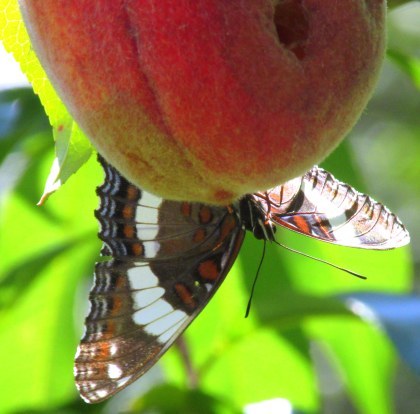
And here’s the red-spotted purple version on buddleia in the garden, seven years ago, on 1 Aug. 2012
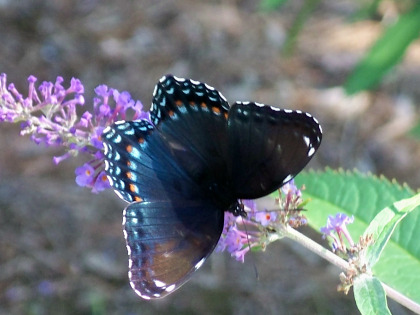
*
Early in the season we had some small fritillaries, which are so common in the south (Jekyll island, GA, for instance – especially gulf fritillaries) but not as much up here. This one was seen on 24 July 2019. I think it’s a great spangled fritillary (Speyeria cybele). We also have an aphrodite fritillary (Speyeria aphrodite) here, somewhat smaller but otherwise I can’t tell them apart.

*
These are all skippers, a small butterfly; I don’t know their species (there are almost 40 species of skippers in New Hampshire). There were a bunch around the yard in July.

27 July 2019

11 Aug. 2019 on echinacea … maybe Peck’s skipper (Polites peckius)
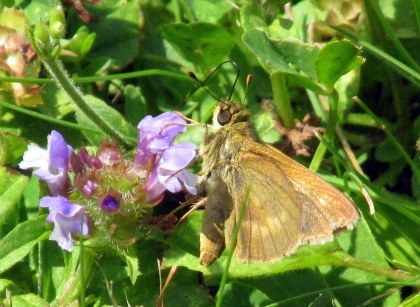
27 July 2019 on self-heal in the lawn
*
I saw a few duskywing butterflies (genus Erynnis, a kind of skipper) in July and August, including this one (I think):

duskywing butterfly (Erynnis spp) on echinacea, 3 Aug. 2019
There are 12 or so species of duskywing, sootywing, and cloudywing butterflies in New Hampshire and they all look kind of alike.
*
Here are a few more butterflies I’ve seen this year in places that aren’t my garden.
This one wasn’t even in New Hampshire, but I rarely see an Eastern comma (Polygona comma) butterfly:

Eastern comma butterfly (Polygonia comma), Laudholm Farms in Wells, Maine, 9 Sept. 2019
A couple of sightings of the common buckeye butterfly (Junonia coenia).
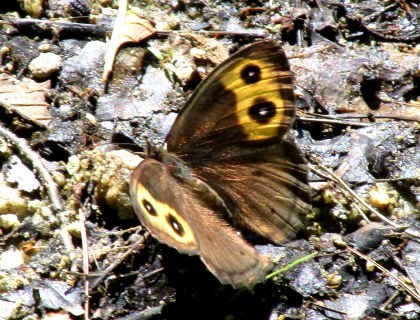
New London, NH, 26 Aug. 2019
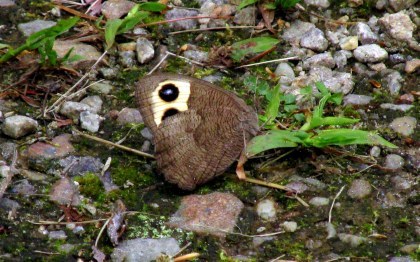
Great Bay NWR, Newington, NH, 23 Aug. 2019
*
A northern spring azure (Celastrina lucia) — I see many azures (both spring and summer species) but they are very small and very fast, hard to capture on film.
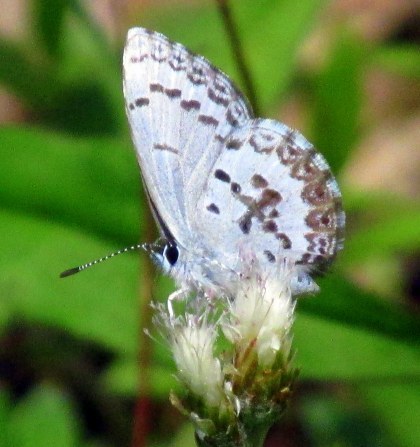
northern spring azure butterfly (Celastrina lucia), 25 May 2019
*
A crescent butterfly, probably a northern crescent (Phyciodes cocyta), but possibly a pearl crescent (Phyciodes tharos).

crescent butterfly, Enfield, NH, 19 June 2019. There are three kinds in NH — tawny, northern, and pearl; I think this is the northern crescent (Phyciodes cocyta).
*
A clouded sulphur (Colias philodice) butterfly, at The Fells Estate in Newbury, NH, 22 Sept. 2019, on pink asters:
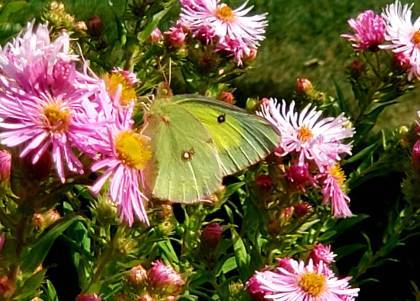
*
This eyed brown (Satyrodes eurydice) butterfly was a new one for me. The common names — eyed brown and marsh eyed brown — just sounds incomplete to me. There’s also a Satyrodes appalachia, Appalachian brown or woods eyed brown, which is very similar (they were previously thought to be the same species), and it’s possible that’s what this is, but people who know more than I do about these things identified it as S. eurydice.

Satyrodes eurydice (Eyed Brown/Marsh Eyed Brown butterfly), Sutton, NH, 5 July 2019
*
Finally, these butterflies are fairly common here but I haven’t taken any photos of them (or even noticed a copper) yet this year, so I’m including garden photos from previous years.

cabbage white (Pieris rapae) butterfly on ‘Bluebird’ Aster laevis, 27 Sept. 2018.
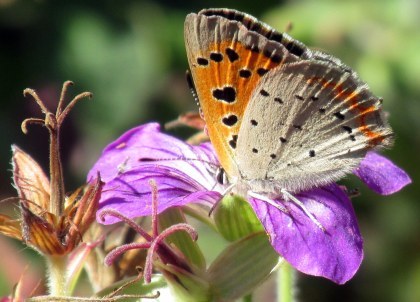
American copper (Lycaena phlaeas) butterfly on geranium, 18 Sept. 2015
I’ve never seen a mourning cloak (Nymphalis antiopa) in my garden but I see them along some trails in early spring; their our earliest butterflies. I actually saw one this spring but couldn’t get a good shot of it, so here’s a mourning cloak along a trail in Concord, NH, 23 April 2016.
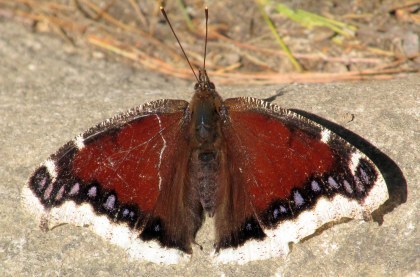
*
Sources:
The Animal Kingdom, by Joe Lewis, Yale-New Haven Teachers Institute Ask a Biologist: True Bugs, by Adam Dolezal and Page Baluch Phylogenic List of Insect Orders Hummingird Moth (Mass Audubon) Side-by-Side American Lady and Painted Lady butterflies (Mass. Butterfly Club) Wildlife Journal Junior – NH PBS – list of insects (mostly butterflies) in NH
Featured image: monarch butterfly drying wings after eclosing, 11 Sept. 2019.
Garden Insects: Butterflies, Moths, and Caterpillars (Lepidoptera) Last year, I wrote a post on some wasps and bees I've found in my garden over the nine years I'd lived here.
#American lady#butterflies#caterpillars#clearwing moths#dagger moth#fritillary#insects#larva#lepidoptera#monarch#moths#painted lady#skipper#swallowtail#taxonomy#tiger moth#tussock moths
0 notes
Text
Growing Apples in Cold Regions
Growing apples is a long-term involvement. Garden crops are mostly annuals, so if something goes wrong you may be out for a year, but you can try things differently next time. Apple trees require several years to bear fruit, and they do not have large crops for a decade, so an early mistake cannot easily be corrected. On the other hand, when knowing how to care for apple trees, they are a lifelong addition to your landscape, growing more beautiful and productive with each passing year.
A lovely apple tree
Apples do not come true from seed, so if you want a particular variety, the tree will be grafted. The desired variety is attached to roots, which offer special characteristics such as tree size or cold hardiness. When you plant trees you must pay attention both to the variety and to the rootstock. Labels on trees sold at home centers and big-box stores often say nothing at all about the rootstock, and many nursery catalogs have only scanty information. If you’re growing apples in a cold region, this is a big issue. My orchard is in northern Maine where winter temperatures can dip below -30°F, and most commercial rootstocks will not survive. In this area, the Russian standard rootstock Antonovka is the only one really reliable.
Several nurseries such as Fedco Seeds (PO Box 520, Waterville, ME 04903; 207-873-7333 or 207-430-1106) and St. Lawrence Nurseries (325 State Highway 345 Potsdam, NY 13676; 315-265-6739 offer trees on this rootstock.
Updated Composting Guide: Learn to compost chicken manure!
Avoid common composting mistakes with this Free Guide. Successfully make your own garden gold with help from our experts. YES! I want this Free Report »
Dwarf trees have been popular in recent years, but they are a poor choice when growing apples in cold regions if the snow cover is deep, and there is significant wildlife pressure. Deer will browse all foliage and branches up to four feet, and they will stand on their hind legs to pick apples even higher up. Moose can easily reach seven feet, and they will tear small trees entirely apart. Snowshoe hares girdle trees in winter; they walk on top of the snow, which reaches four feet deep here. Trees of any size must be diligently fenced when young, but dwarf trees never outgrow their predators, so you will be dealing with fences as long as you have the trees. Deep snow will also tear off low branches or fold small trunks in half, even without any wildlife. If you have any of these issues where you live, perhaps growing apples on dwarf trees isn’t the best choice.
Standard-sized trees are the best choice for growing apples in extreme climates. Be aware however that you will be in for a lot of work on ladders, as the trees get older. Apple trees will not grow well on poorly drained soil, which is one reason they are usually set out on sloping ground. If possible they should be visible from the farmhouse, so you can keep an eye on problem wildlife. Standard trees need to be at least 25 feet apart, and even then large trees may fill up their spaces in 15 years or so. With 25-foot spacing, an acre will hold about 70 trees, but that is a lot of work, and five or six trees will suffice amply for the home supply.
The soil fertility should be average. Too much fertility can delay fruiting. Soil pH should be somewhat acid, 5.5 to 6.5. Since apples are generally not self-fruitful, you will need several different varieties. Pollination is done by wild bees and other insects, and if your property has abundant wildflowers throughout the growing season, you will have no trouble getting your apple trees pollinated. Heavy frost will destroy open blossoms, but they can sustain marginal frost without injury.
Problem wildlife comes in small sizes as well as large. Voles (field mice) girdle tree trunks in winter under the snow. To prevent this, use plastic spiral tree guards as high as the snow line and then some. It is hard to put the guards on trees over three inches in diameter, but these are still at risk of girdling, so plastic fabric wrap can be used instead. Girdling is rare on trees over six inches in diameter, although not entirely unknown. Borers kill many young trees, which should be inspected every two weeks during the growing season.
Grubs coming out a tiny hole near the bottom of the trunk betray their presence, either rust-red when they begin their work in the bark, or bright orange after they have dived into the wood. The solution is to carve them out with a knife. This seems brutal, but it is better than leaving the borers in the tree. If they have gone too far into the wood to be reached, it may be helpful to stuff the hole full of tobacco. Ribbon-cut chew or pipe tobacco is easier to use for this purpose than the shredded stuff found in cigarettes or snuff. I have only begun to use this method, but so far it seems to work. American mountain ash is a common alternate house for borers, and should, if possible, be removed from the vicinity of the orchard.
If you live in an area where ruffed grouse are common, you may be in for a lot of labor. The birds are commonly called partridge. They eat tree buds in winter and are partial to apple trees. Leaf buds will regenerate in spring, but not fruit buds, which require two years’ formation. If the partridge disbuds your trees, you will get no fruit. The birds themselves are good eating, and the hunting season lasts all fall, but if you don’t get them all, the only way to deter them is to patrol your orchard every daylight hour in the winter. This is why growing apples near the house is so handy. You can make a scarecrow or use fake owls, which will not impress the birds, nor are they deterred for long by flash tape. And they work in all kinds of weather except high winds.
It is possible to grow a large percentage of high-quality fruit without poisonous sprays, although some non-toxic spraying may be necessary depending on the kinds of pests you have. If you live in a region where there are large abandoned orchards, this will make growing apples harder. Pruning the trees, and thinning the crop, are two important ways of improving fruit quality. Pruning allows light and air into the tree’s canopy for better fruit development and reduced disease conditions. Thinning the crop when the fruit is about the size of a dime, to an apple every six inches or so, will allow the tree to concentrate its resources into the fruit that is left.
Apple scabs
Here are notes on some common problems when growing apples:
Apple scab: A fungal disease, is found everywhere except perhaps in arid irrigated Western regions. It makes rough black spots on the apples, and early-infected fruit will also crack and break open. Avoid highly susceptible varieties such as Snow-McIntosh, or Norland. The fungus overwinters mainly on the fallen leaves, so if every year you remove as many of the leaves as possible and compost or burn them outside the orchard, you will greatly reduce the problem over time. Alkalinity inhibits scab so if leaf removal is not feasible, many growers lime over the leaves in fall but beware of soil pH if you do this. Many growers are also spraying sulfur for scab control into summer, and this tends to make the soil more acid. I don’t much care for the idea of repeatedly lowering soil pH with sulfur and then raising it again with lime, year after year.
European apple sawfly: Active during bloom. Their tiny eggs hatch when the fruitlets are minuscule, and the larvae produce winding scars under the apple skin. Later they dive inside. The best control is to inspect the crop during thinning and a couple of weeks later, to remove obviously affected fruit. Much of it will also fall during a period of natural thinning which occurs about four weeks after blossom, called the June-drop although it happens here in early July. Drops should be collected at least once a day. All such culls should be discarded at least a mile from the orchard (but not near someone else’s trees!) or destroyed by boiling. Curculio, a small black or brown weevil, is difficult to control, and if populations get large, you can lose the majority of your crop. Early in the season, the weevils make cosmetic scars on the fruit in the shape of a small half-moon. In mid-season they breed; the larvae tunnel around in the fruit, which becomes shrunken and misshapen. Of all apple problems, this is the most disheartening. Curculio can be deterred by spraying with specially refined kaolin clay, sold under the commercial name “Surround.” Coverage must be applied just as the blossoms begin losing their petals (“petal fall”) and continued for four or five weeks. This will cost about $40 for every three or four standard trees per season. Correctly sprayed trees will look oddly white. Use of kaolin will delay fruit maturity by a few days, and it may also increase tendencies towards biennial bearing. A few trap trees must be left unsprayed to give the weevils somewhere to go, otherwise they will wait until you stop spraying and come back. Early-maturing apples work best as trap trees. Many areas of the country do not have curculio at all, or if you do have them you may find that they affect primarily one part of the orchard to another or just certain varieties.
Codling moth: Larvae begin to appear in some numbers when the season is about half over. They produce a brown granular frass, usually at the calyx end (bottom) of the apple. They tunnel to the core and eat the seeds. In my short-season area, codling moths have one and a half generations, but in warmer climates they have two or even three full generations, multiplying in numbers each time. Here, the early varieties such as Yellow Transparent or Red Astrachan largely escape the problem. Numbers can be greatly reduced over time simply be discarding all affected apples in the woods far from the orchard as described above; wildlife will eat the fruit in short order, and any larvae that escape will find no food when they emerge next spring.
A fresh, delicious apple
Apple varieties
About 200 apple varieties are available through nurseries, and many more can be located through apple collectors. When growing apples in cold weather, growers must give attention not just to the hardiness of the trees, but also to the length of the growing season. Some varieties may be hardy enough in the wood, but may never mature their fruit in a short season. Nursery catalogs give insufficient attention to this problem, but if you live in a short-season area, avoid any apples described as “late” even if they appear to be sufficiently cold hardy.
Light frost will sometimes make apples sweeter, but heavy frost ruins them. I’ve tried growing apples of about two-dozen different varieties and find these to be real winners in my cold climate:
State Fair: A sweet apple, it is my favorite for fresh eating. It was developed in Minnesota but seems to be unknown in New England even though it does well in cold regions here. It is somewhat susceptible to apple scab, but faithful leaf removal in the fall will make a big difference when growing apples of this variety. State Fair apples are medium-sized and bright red. They keep about two months in cold storage and are very useful for applesauce.
Dudley: A large yellow with a red blush on the sunny side, it is fairly resistant to apple scab. It is a robust tangy apple good for baking, and for fresh eating if you like your apples tart. The tree, however, has a pendulous growth habit and it may be a challenge to keep wildlife away from the low-hanging branches. It originated as a seedling of Duchess of Oldenburg, an even stronger-tasting apple widely used for baking, but Dudley keeps better.
Viking: A deep red apple, almost purple with the flesh stained pink inside. It makes a wonderful pink applesauce. The apples are best when fresh, but can be stored up to two months. The tree gets large, and its size may have to be controlled by pruning. When growing apples of this variety, be sure not to pick them too soon as the apples color up early.
Red Baron: A mildly sweet, and if you like strong-tasting apples you might even call it bland. When fully mature it sometimes has a faint under-taste of honey. It is often large and is an eye-catching bright red, and it sells well commercially. Baron is a smallish tree and the fruit is resistant to apple scab. It keeps quite well although it tends to develop brown core after long storage.
Burgundy: A crisp-fleshed purple apple with a tangy taste. It stores exceptionally well, four or five months although the taste gets milder over time. The apples are ready for picking here at the very end of September, and Burgundy is among the latest apples which can be grown successfully in this climate, though always described as a mid-season apple elsewhere. The tree holds its leaves unusually late, which could pose a problem if you get an early ice storm.
If you find a local apple you would like to propagate, rootstocks are readily available from the better-stocked nurseries. Grafting is done just before buds break in the spring. Many books tell how to do it. Apples are not difficult to work with. If you take care to match up the cambium layers (between inner bark and sapwood), and wax the joint well to prevent the graft from drying out, you will probably have success even as a beginner.
Self-sufficiency is the obvious goal of the homesteader, and what could be better than a ready supply of fresh fruit? Beauty in the landscape is another major desire. Growing apples contribute to the cause both ways.
For expert advice on this and nearly every other subject relating to apples, I highly recommend Michael Phillips’ book The Apple Grower (available from the Countryside Bookstore).
What other problems have you encountered when growing apples in cold regions?
Originally published in Countryside and Small Stock Journal May/June 2012 and regularly vetted for accuracy.
Growing Apples in Cold Regions was originally posted by All About Chickens
0 notes
Text
Varieties of beneficial or bad bugs for your garden
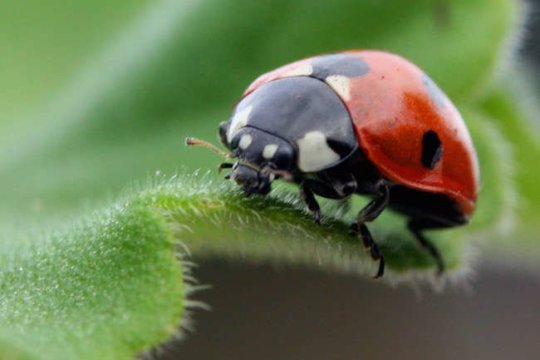
Garden is a place of our house where we can spend our free time and decorate our home with plants and flowers. Garden of our house is same as our friend, and it is a mirror of the home. Now we will discuss garden insects. Maintain your healthy garden it's important to learn about the bugs. A garden is a place where bugs come. When you spend your time in the backyard, you will see their many types of bugs. Here with the help of professional gardening company in Melbourne, we create a list of bugs that every gardener must familiar with. But before checking out the list, let’s come to know about the bugs.
Garden insects are natural, and they come in the garden without any invitation. Bugs come in the yard when blooming flowers, plants and herbs are attracting them with sweet nectar. There are many friendly bugs, and bad bugs are involved in our garden. Friendly bugs are essential for our garden that can preserve our garden from many diseases. Some bugs are beneficial for organic compost. Natural bugs keep your garden brilliant and healthy. They make the garden soil nutrient and fertilizer. Some good bugs are eating the bad bugs and protect our garden from their attack. Beneficial insects also called helper of the backyard.
Bad bugs are that which eats the leaves of flowers and plants. They destroy our garden day today. Some bad bugs attack the beneficial bugs and eat them. So, lets check out the list of some good and bad bugs:
Now we will discuss beneficial bugs of the garden. There are many useful bugs for our garden as below:
Green Lacewings larvae: It is a beautiful species feed on nectar flowers, pollen, and honeydew. It's nicknamed "aphid lions." Lacewings larvae hunt for soft prey especially aphids, mealy bugs, mites and Lepidoptera eggs. Some adult’s lacewings supplement the diet with pollen or honeydew. They eat them with their curved, pointed mandibles victims. Most of the lacewings larvae have copper-colored eyes some lacewings green in body and wing color some larvae have transparent wings, and they look open. They have also chewing mouthparts and have long filiform antennae.
The life cycle of lacewings larvae undergoes complete with four life stages: egg, larva, pupa, and adult. Mostly grown larvae will live for 4 -6 months. The female lacewing produces thin stalk, which it usually attaches to the underside of a leaf. A female worm places an egg at the end of the stalk. Some larvae lay their eggs in the group and some are laid their eggs singly. Green lacewings may be found in herbs, flowers, and grassy areas.

Lady beetles: everyone knows about the ladybug, but gardener loves it very much because of lady beetle is the good friend of the garden. It has dome-shaped back and flat underside. It displays bold colors and markings, red, orange, or yellow with black spot. It has small legs that tuck under the body. Mouth parts of the ladybirds always hidden beneath a large pronotum and mouth parts are also for chewing. Diets of the ladybugs are predators with ravenous appetites for aphids and soft-bodied insects. Some ladybug's like to eat mites, white flies and scale insects.
The life cycle of ladybug: Before mating ladybirds eat several hundred aphids and laying their eggs on infested plants. Ladybug larvae also feed aphids. Ladybugs also complete their four stages of life cycle. Egg, larvae, pupa, and adult. A female ladybug lay up 1,000 eggs within few months. Larva comes out from eggs in four days. Larvae color are orange and within 3 to 15 days the adult ready to mate and feed.
Bees: They are flying insects, and it is a most important for our garden. And they play an important role in the planet's ecosystem. Most crops grown for human depend on bees. .84% of the crops that are entirely dependent on the person depends on the bees because bees pollinate the consumable plants. Bees pollinate with their legs when they collect sweet nectar from flower to flower. All fruits and flowers pollinated by bees.
Earthworms: Earthworm play essential role to compositing or decomposition. They break up the soil. These are found in the ground, feed soil and dead into the ground. It is a U tubed and segmented worm. An earthworm's scientific name is lumbricine. The length of the adult earthworm 10 mm long and 1 mm wide.
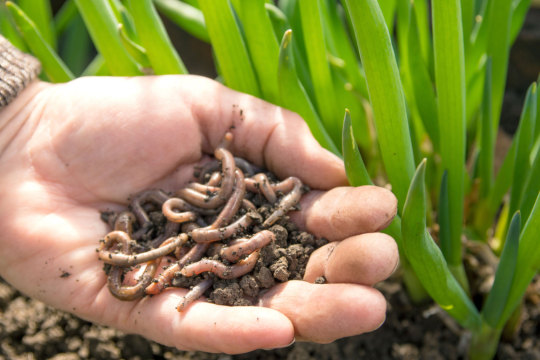
Ground beetles: Ground beetles are found in your garden's soil. They live soil beneath mulches, around compost piles or the sheltered areas. And they have 11/2 inches long colorful, shiny and hard-shelled. Ground beetles are beneficial for our garden to make it an organic garden. Some of them harmful for our garden because they eat helpful insects. Ground beetles eat insects that move, including slugs, earthworms, snails, cabbage beetles.
Praying mantids: These bugs have large eyes and swiveling head and mantids entertain us. When mantids are sitting, they make praying posture. Most mantids are 5-8 centimeters in length. Mantids flying from place to place and they move slowly and prefer to walk of branches and leaves of the plant. Mantids have two large eyes and they can see all around there, and they have pairs of legs. The first pair of legs distinctively forward and allow mantids to catch insects or other preys. Typically they are green or brown color. Mantids eat insects and other small victims sometimes they feed beneficial insects. The life cycle of mantids has three stages: eggs, nymph, and adult. Female mantids lay 200 or more than 200 eggs. Eggs hatch and nymph grows day by day and changes into the adult. Mantids change their color according to plants.
Syrphid flies: Syrphid flies are beneficial flies for our garden. Syrphid flies also called hover flies. That flies play a major role in the plant. Without hover flies pollination of flowers or plants are impossible. Hoverflies include butterflies, bees, and other flies. They feed nectar from flowers or plants. They pollinate the plants in our garden. Syrphid flies also have four stages: eggs, pupa, larva or adult.
Spiders: Spiders are beneficial for the garden because they eat many insects which are harmful to our garden. They eat predatory mites, scale insects, wasps, caterpillars, aphids, mealybugs, moths, butterflies, plant bugs, thrips, leafhoppers, cucumber beetles, flies and other tiny insects. Spiders have eight legs, and it has only two body regions. A cephalothorax and abdomen along with wing, antenna, and unique mouthparts. The lifecycle of spider is that female spider laid the egg and after laying an egg, female spider dies. Spider spreads the web from their mouth to capture their meal.

Big-eyed bugs: Big-eyed bugs feed thrips, leafhoppers, aphids and other insects that would destroy our garden. They are the best friend of the backyard. They live longer than other bugs. Adults have black, brown or gray color. Big-eyed bugs have more tolerance insecticides than other bugs.
Damsel bugs: That bugs eat aphids, small caterpillars, thrips, leafhoppers and other pesky pests. Damsel bugs found in the vegetable garden. These bugs no damage the plants. You can collect them and release them from the backyard. Damsel bugs have gray or brown color. They have long, narrow head with 3/8 to ½ inches long elongated bodies. They have angled antennae and have four wings on their back when they fold their wings that make X-mark on their back. Damsel bugs very quick moving prey. Damsel prey fly when they feel disturbed.
The life cycle of damsel bugs is different than another prey. Damsel females' lay their eggs in plant tissues and their eggs hatch in one week. Damsel nymphs begin eating immediately. development of nymphs for 3 to 4 weeks then molt to adult.There are many generations of damsel bugs according to the season.
It's important to survive your garden from bag bugs. Bad bugs destroy the garden. Now we will discuss bad bugs of garden
Aphids: Aphids are small, soft-bodied bugs. They have pink, green and black color. They feed leaves, buds, shoots, and flowers. They are the big cause of distortion.
Birch leaf minors: It is a flat look larva, and adult sawfly has black color. They feed inside of foliage, which turns the leaves into brown color. They found on birch trees.
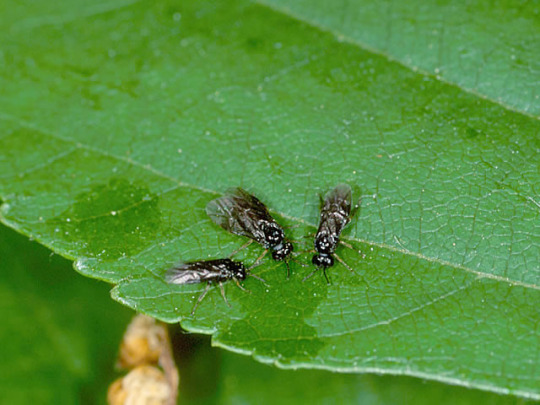
Gypsy moth: It is a black, brown or red color larva. They feed roots of plants and trees. They will destroy the plants.
Colorado potato beetle: They have reddish orange and yellowish, black and orange colored strips. They feed potato, tomato, eggplants. They eat the veins of the leaf.
Crucifer flea beetle: They are metallic blue-black colored beetles. They feed on leaves and leaving shot-hole appearance.
Read Also: Money Saving Gardening Tips
0 notes
Text
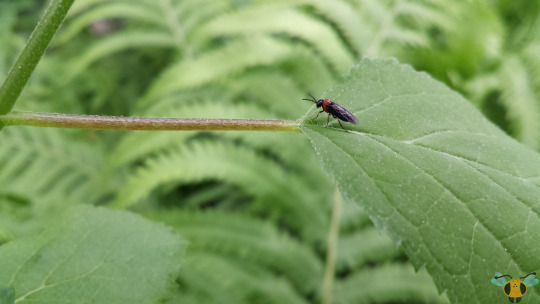
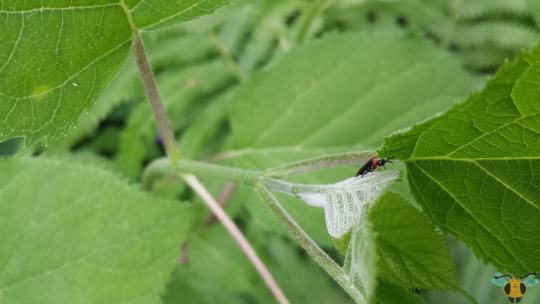
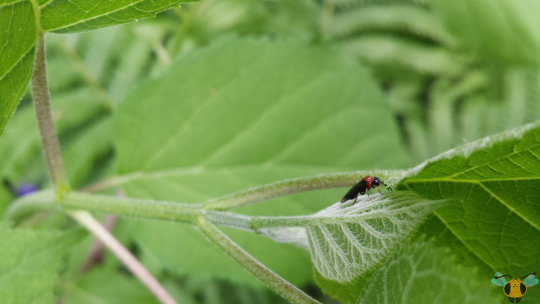
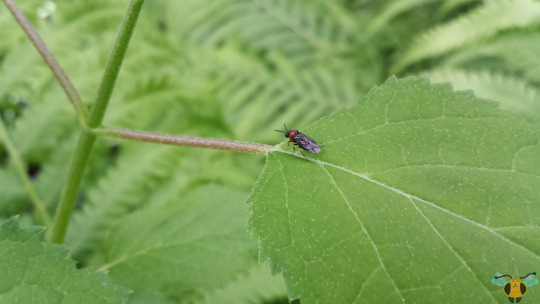
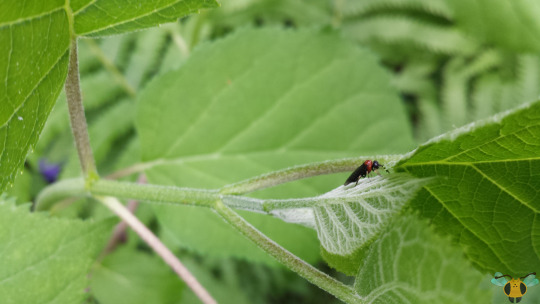

Lawn Sawfly - Eutomostethus ephippium
The adult form of this insect (as seen in the pictures here) has a beautiful red-orange thorax to take notice of when you see it. The rest of its body is black, with the sole exceptions being the tibia and (occasionally) the tarsus (the knees and feet). Aside from the saw-shaped ovipositor in females, there aren't differences between males and females, so this is what to look for a quick possible identification for this specie. Every so often however, a melanistic form of this Sawfly could appear, resulting in the bright thorax appearing in a pitch-dark color. Color variations like this have been noted in Britain, but lucky for us, the white tibias remain intact for identification. This insect seems to adventive in North America, which is to say that it likely established itself after arriving from Eurasia. Fortunately, it doesn't appear to have pest status whether here or across the world. This may be due to its bluegrass-focused diet as a larva. This is a first for the blog since their previous Sawflies have preferences for trees or more ornamental plants. Though benign in most cases, I suspect that these insects could be a lawn nuisance if they aggregated and left frass as they fed! The larvae seem somewhat easy to spot against a background of green. Examples I've research show E. ephippium larvae have a grey complexion along their bodies and faded orange heads. For a reference point, picture a Tiny Yellow Sawfly Larva, but with less extreme coloration. If concerned it would best to monitor your grasses as soon as spring begins as overwintering Sawflies could emerge quickly in search of suitable host grasses!
Pictures were taken on May 26. 2019 with a Samsung Galaxy S4.
#jonny’s insect catalogue#ontario insect#sawfly#eutomostethus ephippium#lawn sawfly#hymenoptera#insect#toronto#may2019#2019#nature#entomology#invertebrates#arthropods#animals#photography
3 notes
·
View notes
Text
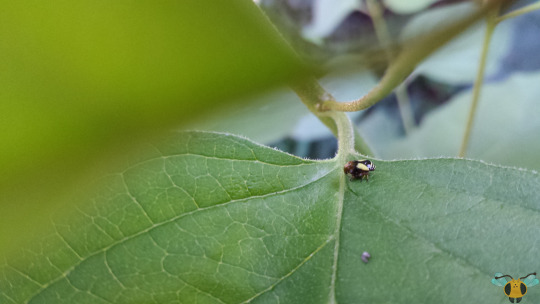
Dogwood Spittlebug - Clastoptera proteus
As far as this little Bug goes, this is the only picture I have of it. I had hoped for more pictures, but since they're so tiny, finding another specimen has proven difficult. A Hopper like this one can also be very skittish...yet another reason why this is the only picture at time of writing. Although tiny, this insect's most common form (pictured here) is very distinct and easily identifiable with its compact body and yellow forewing marking along the body. There are many variations in color: some individuals have more black and others more yellow, and in some cases the yellow wing patch may be completely darkened! In order to conclusively identify this Spittlebug, look to the head and discover a series of yellow/black bandings. Similar species within Clastoptera lack this banding. Without this, a common form C. proteus can easily be confused for the similar-looking Heath Spittlebug (C. saintcyri), while melanistic forms are reminiscent of C. testacea (the males specifically). Identification could be tricky, but these brightly colored specimens are simple to identify compared to other North American "Clastopterans" that have a brown, mottled appearance. Picture the patch on the rear wing of this individual, but coloring the whole body! A dissection microscope would be an essential tool for distinguishing between species!
This picture was taken on July 7, 2018 with a Samsung Galaxy S4. I hope to find another example of this insect in the coming years. At least one more, perhaps on its host plant: dogwood. At the very least, other insects might be found since that tree is a popular host with insects beyond this one such as the Dogwood Sawfly and Dogwood Calligrapha Beetle.
#jonny’s insect catalogue#ontario insect#spittlebug#dogwood spittlebug#true bug#hemiptera#auchenorrhyncha#insect#2018#july2018#toronto#nature#entomology#invertebrates#arthropods#animals#photography
6 notes
·
View notes
Photo

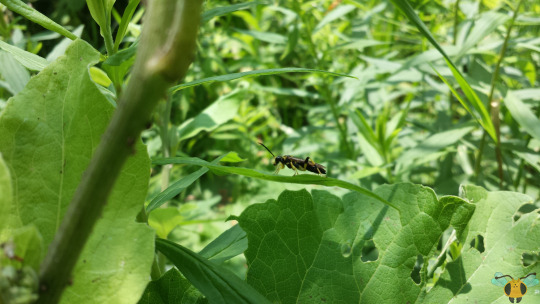
Macrophya Sawfly - Macrophya formosa
I’ve been sitting on today’s specimen for a soon time now hoping that more would be found and thus I’d have more photos to share with you. Nearly four years at time of writing and there’s been no fortune to find another Macrophya formosa Sawfly in the yards, neighborhood, or even the parks! Let’s see what we can gleam from this capture and take it as a prelude for the other posts to come this week. With the coloration across its body and legs, it likely makes its way through the wilderness of High Park by acting as a Wasp mimic. The smoky wings are likely a big help in maintaining this guise, as it only uses its saw stinger to lay eggs. If the heart-shaped marking on the top of its thorax is any indicator, she is harmless and possibly a friend. As this specie lacks a common name, it could be called the “Yellow Hearted Sawfly”, and its host plant could also be included in the name as well, but info is lacking as described below.
While tough to tell, hidden beneath the wings are reddish-brown abdominal midsection stripes that indicate that this park inhabitant is a female; male abdomens lack the markings and are all black. They also sport different color patterning on the legs but I need to look at more images to be sure. This sexual dimorphism (where females are brightly colored while males lack markings) seems to be prevalent through the Macrophya genus based on other species found during the identification process (of course, it’s not the only Sawfly to have this trait). It’s handy to know as there’s little easily available information on this branch of Sawfly and it could be beneficial to learn more about these insects and their habits and host plants. Especially host plants! While in managed wilderness there may be more plants to go around, pest Sawflies can have a field day with residential gardens in their host plant is there. Just ask the Tiny Yellow Sawflies how that goes.
Pictures were taken on July 10, 2019 with a Samsung Galaxy S4. Please look forward to more Sawfly pictures this week.
#jonny’s insect catalogue#ontario insect#sawfly#macrophya formosa#sawfly macropha formosa#macrophya sawfly#hymenoptera#insect#toronto#high park#july2019#2019#entomology#nature#invertebrates#arthropods#photography#animals
1 note
·
View note
Photo









Tiny Yellow Sawfly - Monostegia abdominalis
Over the last few days I’ve been digging through my Sawfly pictures from 2017 to the present day. Looking into a few online resources, it was clear that several of them have been misidentified (nothing on this blog of course). As such, the Sawfly section of the blog has been changed to reflect this and the reserved pictures of the species have been identified accordingly, though there are still a few left to verify. The individuals on showcase were one such specie, the Tiny Yellow Sawfly. If it looks familiar, you may recall that it’s been seen on this blog from the showcase of its larval form. I originally have these pictures pegged as Rose Sawfly adults (Arge ochropus) but looking more closely at them revealed some problems. Though they look fairly similar, even including the wings, but the Tiny Yellow Sawfly lacks the banded patterns across the end of the legs (soccer socks) and has a different proportion of orange and black across its thorax. Both species were likely to habit the yard due to the presence of roses and other plants, but now, we have confirmation, and finally the adult form of this insect can be showcased in all its glory. It’s amazing how the metamorphosis can change a grey wriggler into a vibrant black and orange creature.
Moreover, while writing this post I was reminded of a previous one where I accidentally identified the Rose Sawfly as this specie. Oh goodness me. I suppose that’s a testament to how tricky insects can be to identify, especially the smaller ones. I promise to do better in the future to make the best posts I can. Nevertheless, I’m certain that these are the adult Tiny Yellow Sawfly. They certainly live up to their name, being of small stature compared to previously seen species. Though small, they can get around easily thanks to those wings. Though they stand out on the plants they perch on, I’m certain they’d be much better camouflaged when visiting flowers to obtain nectar and pollen. Since they lack the wasp-waist seen in most Hymenopterans, it’s almost a certainly that they have an easier time digesting solid food in a manner similar to their larval state. Good thing they can’t be too picky about food as they lack the tools to hunt (beyond small soft-boded insects). The saw shaped stinger at the end of their abdomen is solely used to cut into vegetation to lay eggs. Look to their rear to see it; it’s not needle-shaped like a traditional stinger, but more closely resembles a hand saw when seen up close.
Pictures were taken on May 25 and June 11, 2019 with a Samsung Galaxy S4
#jonny’s insect catalogue#insect#sawfly#tiny yellow sawfly#hymenoptera#toronto#may2019#june2019#2019#ontario insect#entomology#nature#invertebrates#arthropods#photography#animals
0 notes
Photo










Tiny Yellow Sawfly - Monostegia abdominalis
Another year, another infestation of these little guys. There’s a particular section of the backyard where they like to congregate to feast on the plants. I’ve caught a few in the act this time and the damage the inflict on these plants is quite destructive. They begin from the outer edges of the leaves and slowly gnaw their way towards the middle, each individual Sawfly Larva tending to its own leaf. On larger leaves, several of them may feed close to each other. The center vein of the leaf and other major veins are left alone, but the damage to the plant is drastic, not that the larvae notice. They’re just here to engorge themselves and pupate into adult Sawflies. Not only that, if they see you coming, they like to hide on the undersides of the leaves in order to avoid being seen. If you’re gardening, keep vigilant for these hungry critters. This year, while a few were saved, the several plants that were so thoroughly eaten couldn’t grow back their leaves and began to wilt. We had to be pulled out and thrown into yard waste bags.

Don’t underestimate these little creatures! And remember, just because they look like Caterpillars, doesn’t mean they are, and thus doesn’t mean that Caterpillar treatments and sprays will work on them. Look at their heads to reveal what order they belong to. These Sawflies have visible black dots for eyes with a distinct head, while Caterpillars have different structure to their eyes and head. Their proleg count varies as well, but that’s not immediately distinct (still worth noting of course). Like with any insect in your garden, if it can be left alone, do so, but with feeding like this, these individuals cannot be ignored. My preferred method is to catch them by hand and deposit them into the yard waste bag. As soon as the bag is full, it goes right to the curb, and far away from their food source. While harmless to humans, wearing a glove might be better for collection, especially if there is more garden work to do. As you can see, when caught they like to ball up to protect themselves. It is kind of adorable.
Pictures were taken on July 2, 2020 with a Google Pixel 4.
#jonny’s insect catalogue#insect#sawfly#tiny yellow sawfly larva#tiny yellow sawfly#hymenoptera#sawfly larva#toronto#july2020#2020#ontario insect#entomology#nature#invertebrates#arthropods#photography#animals
0 notes
Photo


Tiny Yellow Sawfly - Monostegia abdominalis
While the front yard hosts the Red-Headed Pine Sawfly, it turns out that the backyard hosts this Sawfly. This ravenous little eater has a preference for primrose and loosestrife plants. My mother has been dealing with these insects for years in the backyard, but we both thought these insects were Caterpillars. After a bit of research and comparison to other Caterpillar species, something clicked. Closer observation of the larvae reveals a few differences between them and Caterpillars: with these in particular, the sawfly larva have more prolegs - fleshy limbs rather than true legs - on their abdomen than most Caterpillars do. As well, sawfly larvae have only one pair of simple eyes, while Caterpillars can have 6 pairs of eyes. The adults of this specie are, as their name suggests, very small. Bugguide.net has picture references that showcase the size difference compared to a fingertip and blades of grass respectively.
Like the Pine Sawflies (and other Caterpillars), these larvae love to much on leaves...to the point of total skeletonization of the leaves. This wouldn’t be a problem with just one caterpillar look-a-like, but these pictures don’t show the dozens of larvae munching on the leaves and completely destroying the plant. I haven’t seen them eating the stem, but these insects completely destroy these plants year after year, and mom isn’t happy with that! At least now that we’ve better identified them we can fight them with more than just the garden hose; Caterpillar chemical deterrents don’t work on Sawflies, so Hymenopteran formulated sprays may have better luck. If only we could ask birds and other predatory insects to help us out. In fact, predatory insects don’t even seem to bother with these larvae.
Pictures were taken on July 2, 2018 respectively with a Samsung Galaxy S4
#jonny’s insect catalogue#insect#sawfly#tiny yellow sawfly larva#tiny yellow sawfly#hymenoptera#sawfly larva#july2018#2018#toronto#ontario insect#entomology#nature#invertebrates#arthropods#photography#animals
0 notes
Photo






Virginian Tiger Moth Caterpillar - Spilosoma virginica
True to my word from the first post to feature this fluffy “yellow” bear, there are color variants of this insect to be found. Here we have exactly that: a brown color variant of the Virginian Tiger Moth Caterpillar. It almost resembles a common Woolly Bear with that coloration, but it isn’t as nicely groomed. While some fuzz is uniform, there are a lot of unruly hairs lining the body of the Virginian Tiger Caterpillar. Commonly, they can be found with a fluffy white coat of hairs, but this individual has a darker coat of hairs. How and why these Caterpillars come in different colors is beyond me but it sure does make them more interesting to catalogue and observe. Though it can make them a little tougher to identify, especially when realize that the Salt Marsh Moth (Estigmene acrea) exists and those Caterpillars look very similar to this specie. The color variations even overlap! Right down to the white-colored spiracles, all of which can be seen in Pictures 2 and 5 here. Against the fluff they look like little specks, when in reality these are the Caterpillar’s breathing holes. Quite essential!
Comparing this specie to the Caterpillars of E. acrea, I keep returning to a comparison between the two insect’s heads. While faint, you can somewhat see an outline of the head in Picture 3 and it bares no markings, which is hopefully enough to confirm the identification. Otherwise, content and coated in fuzz, this Caterpillar can do about its cool summer day searching for food and shelter. In the case of food, the young Caterpillar spends its days munching on leaves, using its mouthparts to skeletonize them down to the veins. It seems they prefer low-lying plants that are closer to the ground (like this individual seems to be searching for) but some have been found eating tree leaves. Variation in diet can go a long way in creating benefits between groups such as not having swarms of wrigglers completely depleting a food supply, which tends to happen with skeletonizing leaves (see also the larvae of the Tiny Yellow Sawfly). The Caterpillars aren’t thinking of this of course, as their primary goal is pure and simple: eat enough, grow large, store energy and become a beautiful Moth! It’s hard to be mad at them unless they start eating your garden, but you’re not likely to see a swarm of them.
Pictures were taken on August 18, 2019 with a Samsung Galaxy S4
#jonny’s insect catalogue#insect#virginian tiger moth#moth#virginian tiger moth caterpillar#caterpillar#yellow woolly bear#lepidoptera#toronto#2019#august2019#ontario insect#entomology#nature#invertebrates#arthropods#photography#animals
1 note
·
View note
Photo










European Apple Sawfly - Hoplocampa testudinea
This last while seems to have evolved into a Hymenopteran showcase, unintentional as it was. The initial plan was to just showcase the Dauber Wasps and then move onto another order of insect. But then I found a Yellowjacket queen searching for a spot to make residence and now this surprising find on the windscreen! This little creature is another new specie of Sawfly to add to the blog! While joyous, it also means I need to identify it, and then go and make sure I haven’t misidentified any previous species in older pictures. While this new specie resembles the Tiny Yellow Sawfly, the orange and black head patterning of the head separates the two along with orange-colored shoulders (darkened on this individual). It may look like other Sawflies on this blog too, but those are much larger and far more distinctive. It is a mountain of a process, and yet it’s over something so very small, crawling around on my fingers. For anyone looking to identify insects, don’t let the challenge discourage you; let it inspire you to learn more about all that lives around you.
As the name suggests, this Sawfly is adventive to North America, hailing from Europe. Apples seem to be its food of choice, especially for the larvae. Aside from maybe some crabapple trees in my neighborhood, there’s little for these insects here, but that won’t stop them from searching. They may resort to feeding on similar fruits if they have to, though I feel this would need to be addressed in a follow-up. For now, let’s focus on apples: the larvae seemingly burrows into the apple’s flower after hatching and consumes the seeds as the fruit develops. It also feeds underneath the fruit’s skin, which can leave tunnels similar to those of wood-borers and leaf-miners. They repeat this process across multiple apples which can result in poor or stunted development of apple fruitlets. After a summer of feeding, they fall to the ground with the apples and pupate through the winter, emerging in the spring as an adult, like this individual. Though a bit of a nuisance, the affected percentage of crop doesn’t seem t0o severe, but when taken in conjunction with other pests and multiple areas, the lines become blurred and more research needs to be done on my end. As a precaution, wash your apples before eating them and be wary of any apples with channels visible through the skin. For more info, I recommend viewing this source.
With this, we’ll take a break from Hymenoptera for now and resume showcase on other insect orders. Next week will begin with another new insect that’ll bolster the numbers of an elusive but intriguing order. One who starts in water and emerges onto land.
Pictures were taken on May 13, 2021 with a Google Pixel 4.
#jonny’s insect catalogue#insect#sawfly#european apple sawfly#hymenoptera#toronto#may2021#2021#ontario insect#entomology#nature#invertebrates#arthropods#photography#animals
1 note
·
View note